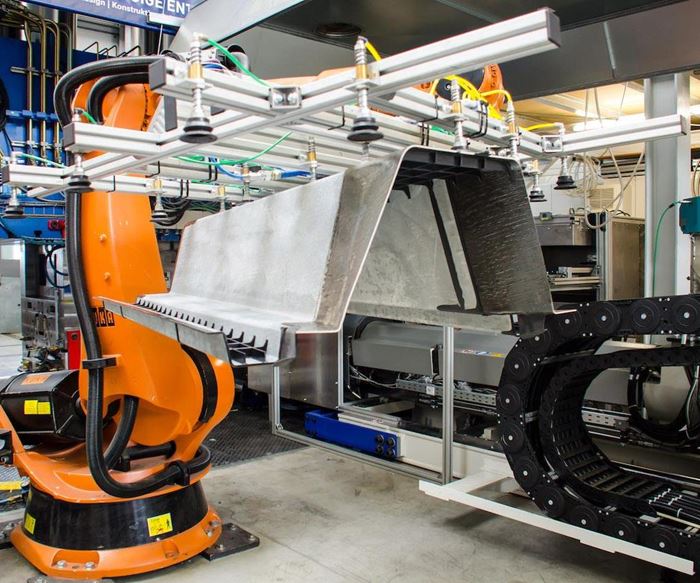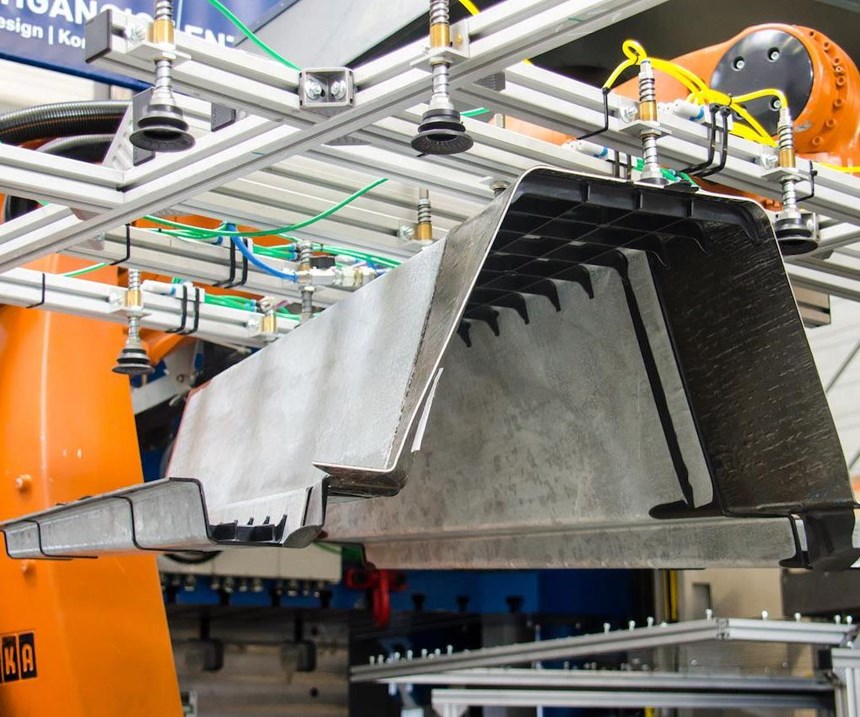KraussMaffei's new one-step forming and back injection for composites
KraussMaffei is working on the development of new hybrid materials and processes in collaboration with the Dresden University of Technology.
KraussMaffei Technologies GmbH (Munich, Germany) is working on the development of new hybrid materials and processes in collaboration with the Dresden University of Technology in Germany. Called the LEIKA research project, the new lab system is at the Institute for Lightweight Engineering and Polymer Technology. This system allows FRP-metal hybrid materials to be formed and back injected in one step.
The objective of the research project supported by the German Federal Ministry of Education and Research is to decrease the structural mass in electric vehicles by using innovative hybrid materials with a focus on processes ready for large-scale series production. "The new lab system at the Institute for Lightweight Engineering and Polymer Technology allows us to form and back-inject FRP-metal hybrid materials in one step. The resulting process and structure quality, together with the achieved cycle times of significantly less than two minutes, supports the potential of such hybridization on both the material and production end," says Martin Würtele, director of injection molding technology development at KraussMaffei.
Another great advantage of the new test system is its flexibility. KraussMaffei served as the system provider and has been closely involved in project engineering from the beginning. The new lab system is suited both for the manufacturing of components by injection molding and for the back injection of semifinished products. In addition, plastics can be used for compression in the mold or reinforcement for local areas in the component. This process sequence is implemented through the integration of a flat sheet die as well as a conveyor belt with an insertion robot. "The new test system lets us project a large number of incredibly varied processes on a single system. This lets us offer significant added value to our partners from the automotive industry," says Michael Krahl, project manager and person in charge of LEIKA at the Institute for Lightweight Engineering and Polymer Technology.
Flexibility is also a subject of major interest in the implementation of individual system components. This is why KraussMaffei designed a bolt-on unit of reduced height which is completely integrated with the production line including a press, infrared oven, robot and conveyor belt. The unit is capable of both injection molding and extrusion, portioning the injection volume in the process. As stated in the requirements specifications, up to five areas can be reinforced locally in one cycle. Another feature of note is the conveyor belt's full integration into the system to make it possible to deposit the individual portions of plastic. "The speed of the conveyor belt results directly from the process parameters, such as injection speed or throughput. This is a clear advantage for the Institute for Lightweight Engineering and Polymer Technology because there is no longer any need to set the conveyor belt manually beforehand and there is no discharged melt. In the event of a change in discharge speed, the conveyor belt speed adapts automatically and with deliberate control," says Würtele.
The software for the system has been completely rewritten. The MC6 from KraussMaffei acts as an open control system that handles the integration of the bolt-on and conveyor belt modules. In addition, it is also completely integrated into the production line electrically.
Another advantage is the high shot weight consistency of the associated SP 12000 injection unit with direct drive. The motors for plasticizing and injection are arranged in a series and directly flange-mounted on the screw, making it possible to prevent transverse forces opposing the flow of force. The result is very accurate metering and precise material discharge shot by shot.
Using the floor structure for electric vehicles as an example, the partners demonstrated the suitability of real-world implementation in series production for the innovative hybrid materials and their processes. For the center tunnel, the scientists combined metallic outer layers of steel with a core of CFRP. "The first test results are excellent. The mass is reduced by 25 percent compared to an all-metal lightweight construction solution. Simultaneously, it was possible to demonstrate comparable performance under the most important load conditions with regard to stiffness and crash situations for components with significantly lower mass," says Würtele.
Related Content
Plant tour: Joby Aviation, Marina, Calif., U.S.
As the advanced air mobility market begins to take shape, market leader Joby Aviation works to industrialize composites manufacturing for its first-generation, composites-intensive, all-electric air taxi.
Read MoreComposites end markets: Automotive (2024)
Recent trends in automotive composites include new materials and developments for battery electric vehicles, hydrogen fuel cell technologies, and recycled and bio-based materials.
Read MoreASCEND program update: Designing next-gen, high-rate auto and aerospace composites
GKN Aerospace, McLaren Automotive and U.K.-based partners share goals and progress aiming at high-rate, Industry 4.0-enabled, sustainable materials and processes.
Read MoreCarbon fiber, bionic design achieve peak performance in race-ready production vehicle
Porsche worked with Action Composites to design and manufacture an innovative carbon fiber safety cage option to lightweight one of its series race vehicles, built in a one-shot compression molding process.
Read MoreRead Next
VIDEO: High-volume processing for fiberglass components
Cannon Ergos, a company specializing in high-ton presses and equipment for composites fabrication and plastics processing, displayed automotive and industrial components at CAMX 2024.
Read MoreDeveloping bonded composite repair for ships, offshore units
Bureau Veritas and industry partners issue guidelines and pave the way for certification via StrengthBond Offshore project.
Read More“Structured air” TPS safeguards composite structures
Powered by an 85% air/15% pure polyimide aerogel, Blueshift’s novel material system protects structures during transient thermal events from -200°C to beyond 2400°C for rockets, battery boxes and more.
Read More




























